
Clematis is a genus of about 300 species within the buttercup family, Ranunculaceae. Their garden hybrids have been popular among gardeners, beginning with Clematis × jackmanii, a garden standby since 1862; more hybrid cultivars are being produced constantly. They are mainly of Chinese and Japanese origin. Most species are known as clematis in English, while some are also known as traveller's joy, a name invented for the sole British native, C. vitalba, by the herbalist John Gerard; virgin's bower for C. terniflora, C. virginiana, and C. viticella; old man's beard, applied to several with prominent seedheads; leather flower for those with fleshy petals; or vase vine for the North American Clematis viorna.

Bedgebury National Pinetum at Bedgebury, Kent, in the United Kingdom, is a recreational and conservational arboretum managed by Forestry England that was established as the National Conifer Collection in 1925 and is now recognised as the most complete collection of conifers on one site anywhere in the world. The collection has over 10,000 trees growing across 320 acres (1.3 km2), including rare, endangered and historically important specimens. Bedgebury National Pinetum conducts conservation work, is home to some 56 vulnerable or critically endangered species, and houses five National Plant Collections.

An arboretum in a general sense is a botanical collection composed exclusively or very largely of trees of a variety of species. Originally mostly created as a section in a larger garden or park for specimens of mostly non-local species, many modern arboreta are in botanical gardens as living collections of woody plants and is intended at least in part for scientific study.

The Birmingham Botanical Gardens are a 15-acre (6-hectare) botanical garden situated in Edgbaston, Birmingham, England. The gardens are located 1+1⁄2 miles (2.4 km) south-west of Birmingham city centre at grid reference SP049854. Designed in 1829, the gardens are Grade II listed and retain many original features and layout, which was designed by the landscape gardener and horticulturalist John Claudius Loudon. The site is notable for its range of glasshouses and gardens, which display a wide variety of plants and birds. Birmingham Botanical Gardens is managed by Birmingham Botanical and Horticultural Society, a registered charity. The gardens are open daily to the public with paid admission.

The Sir Harold Hillier Gardens is an arboretum comprising 72 hectares accommodating over 42,000 trees and shrubs in about 12,000 taxa, notably a collection of oaks, camellia, magnolia and rhododendron.

RHS Garden Rosemoor is a public display garden run by the Royal Horticultural Society in north Devon, England.

Buddleja auriculata is an evergreen shrub endemic to Zimbabwe, Mozambique, and South Africa, growing in montane fields and thickets at elevations of 600–2,000 m. First collected by W. J. Burchell in 1813, and named by Bentham, the date of its introduction to western cultivation is not known, however it was accorded the Royal Horticultural Society Award of Merit in 1923.

Buddleja coriacea is a variable species endemic to the high Andes from the Cordillera Blanca in Peru to Lake Titicaca in Bolivia. It grows on dry to semi-humid rocky soils at elevations of 3,000–4,350 m, where temperatures range from -3° to 15° C. and the winds are both strong and persistent. The species was first named and described by Rémy in 1847.

Buddleja cordata is endemic to Mexico, growing along forest edges and water courses at elevations of 1500–3000 m; it has also naturalized in parts of Ethiopia. The species was first described and named by Kunth in 1818.
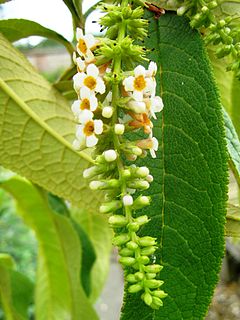
Buddleja forrestii is a deciduous shrub or small tree widely distributed from India to western China. First described by Diels in 1912, he named the species for plant hunter George Forrest, who discovered the plant in Yunnan in 1904 and introduced it to Western cultivation.
Buddleja stachyoides is the most widespread member of the genus in South America, endemic to woodland edges, roadsides and riversides in Argentina, Brazil, Bolivia, Paraguay, and Uruguay. Introduced to the UK as B. australis in 1822, when the Royal Botanic Garden Edinburgh grew it from seed received from a Russian source, the plant was described and renamed B. stachyoides by Chamisso & von Schlechtendal in 1827.
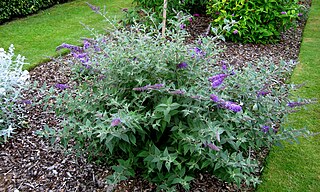
Buddleja 'Blue Chip', which Dennis Werner and Layne Snelling raised at the JC Raulston Arboretum at North Carolina State University (NCSU), is the world's first dwarf Buddleja. The cultivar is the result of the complex hybrid B. weyeriana 'Honeycomb' ×. NCSU released the cultivar to commerce in 2007. NCSU received United States plant patent number USPP19991P3 for 'Blue Chip' in 2009. The public voted the plant to be the second most attractive cultivar of the 97 on display in the Buddleja cultivar Euro-trial that the Royal Horticultural Society conducted at RHS Garden Wisley in Surrey, England, during 2008.
Buddleja 'Ice Chip' is a sterile hybrid cultivar derived from a 2005 crossing of 'Blue Chip' and the breeding parent NC2002-12 in the plant breeding program of Dennis J. Werner and Layne K. Snelling of North Carolina State University (NCSU) at the JC Raulston Arboretum. Werner and Snelling selected ‘Ice Chip’ in field trials in 2006 at the Sandhills Research Station in Jackson Springs, North Carolina. NCSU's North Carolina Agriculture Research Service released the cultivar to commerce in 2011. NCSU received United States plant patent number USPP24015P3 for the cultivar on April 5, 2016.
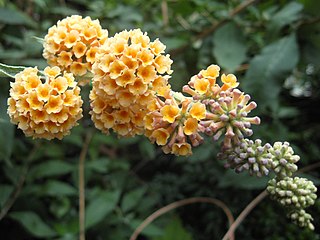
Buddleja × weyeriana is one of the more remarkable Buddleja hybrids, the first crossing of an Asiatic species with a South American. The hybrid was raised during the First World War by the eponymous Major William van de Weyer at his home, Smedmore House, at Corfe Castle, England. Van de Weyer was hoping to achieve an inflorescence the size of davidii with the colour of globosa, but met with only limited success.
Buddleja Purple Haze is a sterile hybrid cultivar derived from a 2004 crossing of 'Miss Ruby' and clone no. NC2003-4: 'Honeycomb' × in the plant breeding program of Dennis J. Werner and Layne K. Snelling of North Carolina State University (NCSU) at the JC Raulston Arboretum. Werner and Snelling selected ‘Purple Haze’ in field trials in 2005 at the Sandhills Research Station in Jackson Springs, North Carolina. NCSU's North Carolina Agriculture Research Service released the cultivar to commerce in 2010. NCSU received United States plant patent number USPP24514P2 for the cultivar on June 3, 2014.
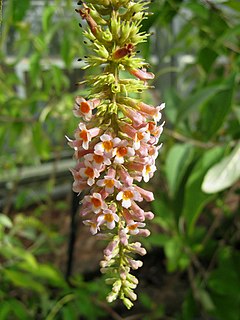
Buddleja macrostachya is a large deciduous shrub or small tree with a vast distribution, from Xizang (Tibet) through western China, Bhutan, Sikkim, northern India, Bangladesh, Myanmar (Burma), to Thailand and Vietnam, growing in scrub on mountain slopes to an altitude of 3,200 m, and along rivers in forests. The species was named and described by Wallich ex Bentham in 1835.
Buddleja 'Blue Chip Jr' is a dwarf hybrid cultivar derived from a 2008 crossing of 'Blue Chip' and clone NC2006-18 in the plant breeding program of Dennis Werner of North Carolina State University (NCSU) at the JC Raulston Arboretum. Werner selected the cultivar in field trials in 2009 at the Sandhills Research Station in Jackson Springs, North Carolina. NCSU's North Carolina Agriculture Research Service released the cultivar to commerce in 2013. NCSU received United States plant patent number USPP26581P3 for the cultivar on April 5, 2016.
Buddleja 'Pink Micro Chip' is a dwarf hybrid cultivar derived from a 2019 crossing of Lilac Chip and 'Miss Molly' in the plant breeding program of Dennis J. Werner of North Carolina State University (NCSU) at the JC Raulston Arboretum. Werner selected the cultivar in field trials in 2010 at the Sandhills Research Station in Jackson Springs, North Carolina. NCSU's North Carolina Agriculture Research Service released the cultivar to commerce in 2011. NCSU received United States plant patent number USPP24016P3 for the cultivar on November 5, 2013.
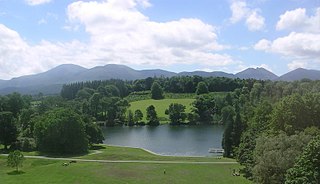
Castlewellan Forest Park is located in the town of Castlewellan in County Down, Northern Ireland.

















